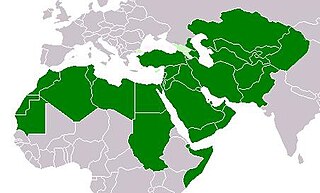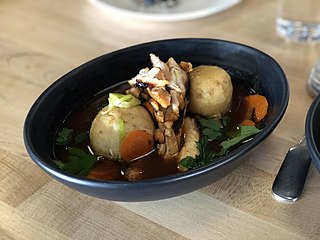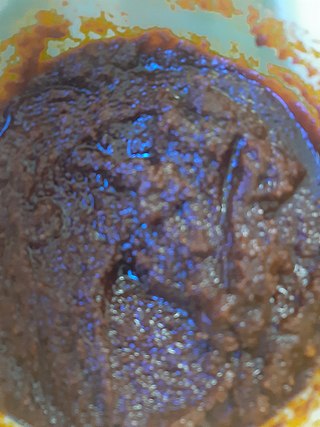Traditional Ashkenazi dishes
Ashkenazi Jews are the Jews descended from the medieval Jewish communities of the Rhineland in the west of Germany. [1] Ashkenazim or Ashkenazi Jews are literally referring to "German Jews." Many Ashkenazi Jews later migrated, largely eastward, forming communities in non German-speaking areas, including Bohemia (Czech Republic), Hungary, Poland, Lithuania, Latvia, Russia, Ukraine, Romania, Belarus, and elsewhere between the 10th and 19th centuries. As many of these countries share similar dishes, and were occupied by the Russian and Austro-Hungarian Empires until the end of World War I, the place where the dish originated is uncertain.
Contents
| Name | Image | Origin | Description |
|---|---|---|---|
| Babka |  | Eastern Europe | Cinnamon and chopped nuts or Chocolate swirled into a challah (egg) bread/cake. |
| Bagel |  | Poland | Circle of boiled and baked yeast bread |
| Bialy |  | Poland | Similar to the bagel, but without the hole, filled with onions and other ingredients before baking |
| Blintz |  | Russia, Ukraine, Hungary | Thin egg pancake wrapped around a sweet mixture of farmer's cheese, potato, or fruit pie filling, similar to a crêpe, but with the ends tucked in and fried again in butter; often served with sour cream. |
| Brisket |  | Central and Eastern Europe | Braised meat from the chest area of a cow |
| Bublitchki |  | Belarus, Russia, Ukraine, Lithuania | Mini hard bagel-shaped sweet breads, commonly eaten with tea or coffee. |
| Challah |  | Southern Germany | Braided egg bread |
| Charoset |  | Apple and nut dish generally served at Passover | |
| Chicken soup |  | A traditional soup for the Sabbath evening dinner, usually spiced with parsley and/or dill, and served with kneidlach or kreplach and vegetables. | |
| Cholent/Chamin |  | A slow-cooked stew of meat, potatoes, beans and barley often served on the Sabbath | |
| Chopped liver |  | Chopped or minced roasted beef or chicken liver, mixed with hard boiled eggs, onions, and spices. | |
| Chrain |  | Europe | Pickled chopped horseradish, sometimes with beets. |
| Eyerlekh |  | Unlaid eggs found inside just-slaughtered chickens, typically cooked in soup | |
| Farfel |  | Small pellet-shaped egg pasta. A Passover version made from matzo is called matzo farfel. | |
| Gedempte fleisch |  | Ashkenazic pot roast, traditionally made with beef, various vegetables, tomato paste, and spices. | |
| Gefilte fish |  | Central and Eastern Europe | Originally a stuffed fish, filled with a mixture of chopped fish, eggs, onions, matzo meal or crumbs, and spices. Nowadays, it usually refers to poached fish cakes or a fish loaf, sometimes made with matzo meal |
| Goulash |  | Hungary | Spicy meat stew |
| Gribenes | Chicken or goose skin cracklings with fried onions, a kosher food somewhat similar to pork rinds. A byproduct of the preparation of schmaltz by rendering chicken or goose fat. | ||
| Hamantashen |  | Triangular pastry filled with poppy seed or prune paste, or fruit jams, eaten during Purim | |
| Helzel |  | Stuffed poultry neck skin. Stuffing typically includes flour, semolina, matzo meal or bread crumbs, schmaltz, fried onions and spices. | |
| Holishkes Huluptzes |  | Europe | Stuffed cabbage or cabbage roll: cabbage leaves rolled around a mixture of rice and meat, baked with tomatoes |
| Kasha |  | Russia, Ukraine | Buckwheat groats cooked in water (like rice) and mixed with oil and sometimes fried onions and mushrooms |
| Kasha varnishkas |  | Russia, Ukraine | A combined dish of kasha with noodles, typically farfalle. |
| Kichel |  | A cookie commonly made with egg and sugar rolled out flat and cut into large diamond shapes. Although sweet they are typically eaten with a savoury dip or topping. | |
| Kishke |  | Beef intestines, stuffed with a mixture of matzah meal, spices and shmaltz, and boiled (like a sausage). | |
| Kneidlach, matzah ball |  | Pale of Settlement | Dumpling made of matzah meal, eggs, and traditionally schmaltz, generally boiled and served in a chicken soup stock. |
| Knish |  | Pale of Settlement | A kind of turnover, filled with one or more of the following: mashed potato, ground meat, sauerkraut, onions, kasha (buckwheat groats) or cheese, and baked or deep fried. |
| Kreplach |  | Boiled dumpling similar to pierogi or gyoza, filled with meat or mashed potatoes and served in chicken broth | |
| Kremzalech | Holland | A potato and shredded chicken pattie fried in oil, typically made for Passover | |
| Kugel |  | Baked sweet or savory casserole made of noodles or potatoes with vegetables, fruits, fresh cheese, or other items | |
| Latkes (Potato pancake) |  | Fried potato pancakes, usually eaten at Hanukkah with sour cream or apple sauce. | |
| Lekach Honey cake |  | Sponge cake with honey, cinnamon and tea. | |
| Lokshen kugel |  | Poland | A sweet baked noodle dish often made with egg noodles, curd cheese, raisins, egg, salt, cinnamon, sugar, sour cream, and butter. Other versions are made without dairy ingredients and with other fruits such as apples. |
| Lox |  | Thin slices of cured salmon fillet | |
| Macaroons |  | Sweet egg and almond/coconut cookies usually made Kosher for Passover. | |
| Mandelbrot (cookie) |  | Russia, Ukraine | Hard, baked almond bread like Italian biscotti. (Also called mandel bread.) |
| Mandlach |  | Home-made "soup almonds" (soup mandel, soup nuts) | |
| Matzah brei |  | A Passover breakfast dish made of roughly broken pieces of matzah soaked in beaten eggs and fried. | |
| Miltz | Spleen, often stuffed with matzah meal, onions, and spices. | ||
| Onion rolls (Pletzlach) | Flattened rolls of bread strewn with poppy seeds and chopped onion and kosher salt. | ||
| Pastrami |  | Romania | Smoked spiced deli meat used in sandwiches, e.g. "pastrami on rye". |
| Pickled herring (Silodka) |  | Russia, Ukraine | Pickled deboned herring with onions; also mixed with sour cream. |
| Pletzel | Unrisen flatbread with sparse savoury toppings like onion | ||
| P'tcha (Galareta) |  | Turkey | Calves foot jelly |
| Rugelach |  | Poland | Flaky pastry spread with cinnamon sugar and chocolate chips or jam, rolled, and baked. |
| Shlishkes | Hungary | A twisted dumpling made with a potato dough (similar to gnocchi but for the shape) and covered with butter and breadcrumbs. | |
| Schmaltz |  | Rendered goose or chicken fat (grease) | |
| Schnitzel |  | Austria | Pounded cutlets of meat dipped in egg and crumbs or matzo meal and fried. Traditionally made with veal, it is nowadays usually made with boneless chicken breast. |
| Sorrel soup |  | Eastern Europe | Also known as shchav, green borscht or green shchi, it is made from broth or water, sorrel leaves, and salt. Varieties of the same soup include spinach, garden orache, chard, nettle, and occasionally dandelion, goutweed or ramsons, together with or instead of sorrel. It may include further ingredients such as egg yolks or whole eggs, potatoes, carrots, parsley root, and rice. |
| Soup mandel |  | See also mandelach | |
| Sufganiot |  | Fried doughnuts, generally eaten at Hanukkah in Israel | |
| Teiglach |  | Small sweet boiled pastries | |
| Tzimmes |  | Sweet stew of carrots and yams, sometimes with raisins or other dried fruit such as prunes or apricots. It is usually vegetarian but can also be made with beef. | |
| Vareniki |  | Ukraine | |
| Vorschmack |  | Russia, Ukraine | Also known as gehakte herring, chopped herring or herring butter. Strong tasting creamy herring spread, served on crackers or bread. Commonly used as a spread. |
| Yapchik | Hungary, Poland | Yapchik is a potato-based Ashkenazi Jewish meat dish similar to both cholent and kugel, and of Hungarian Jewish and Polish Jewish origin. It is considered a comfort food, and yapchik has increased in popularity over the past decade, especially among members of the Orthodox Jewish community in North America. | |


































